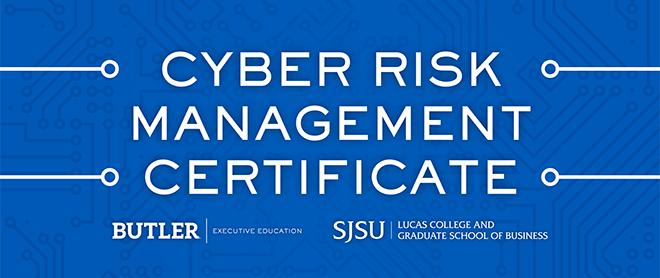Cyber Risk Management Professional Certificate
The Lucas College and Graduate School of Business at San José State University and Butler Executive Education have joined forces to offer the Cyber Risk Management Professional Certificate. Backed
by accredited experts who understand how to effectively manage, implement, and communicate
risk management models company-wide, this certificate offers a powerful collaboration
with San José State University’s wealth of cybersecurity knowledge and Butler University’s
programming in risk and insurance. Together, these two universities provide a proficient
curriculum that gives certificate recipients the expertise to build and maintain a
comprehensive cyber risk management program.![]()

The Emergence of Cyber Risk
What was once solely an IT issue, cyber risk management now impacts the entire lifecycle of an organization. Large consumer breaches and political investigations have put cybersecurity in the forefront of the general public. Increasing digital operations have added pressure for executive teams to effectively navigate and protect their companies and consumers from cybersecurity breaches. Unlike many free training options, the Butler Executive Education and San José State University Cyber Risk Management Certificate is highly tailored to the needs and busy schedules of today’s professionals. This certificate provides a concise, self-paced overview of current cyber risk management trends, tools, and techniques – and how to easily apply them within any organization.
Earn a cyber risk certificate for a one-time fee of $1,995 and 3-10 hours per module
to complete.
Get the Skills You Need
- Understand categories of pure risk and cyber risk faced by various entities.
- Identify and prioritize specific 3rd party errors and omissions and liability risks resulting from IT premises, products, operations, and consulting for treatment.
- Read and interpret cyber risk insurance policies and coverage
- Price specific insurance risks
- Gain organizational buy-in and reporting to c-suite on cyber risk management.
- Reduce overall cost of risk to an organization.
- Determine when to use certain risk management tools and models
- Build and implement a Factor Analysis of Information Risk (FAIR) Roadmap.
Managing Cyber Risk Organizationally
Adopting a cyber risk management approach changes the role of cybersecurity from “gatekeeper” to “business enabler.” But to be successful, cyber risk management requires buy-in and participation at all levels of the organization – from IT and security staff to managers and C-suite. Financially, cyber risk management enables efficient allocation of cybersecurity dollars by focusing security efforts on the resources and goals the organization values most. This prioritization provides the greatest per dollar reduction in the organization’s cyber exposure - the biggest “bang” for the organization’s cybersecurity “buck.”
